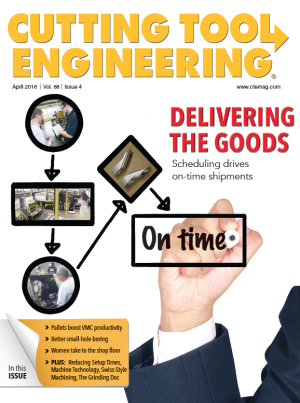I’m thankful to share that our machining business has picked up and we’re running near capacity. I can’t get overly optimistic just yet, but good news nonetheless.
We haven’t required new equipment, new employees or a second shift, but that could change if business continues at this pace or improves. While this uptick has been a nice morale booster, our energy-focused market remains unpredictable. Even so, we’re getting a bit more confident with our forecasts and planning.
Our machine shop performs both primary machining, which is the driver of the current uptick, and secondary machining in support of our fabrication and tooling departments. Because we have a great staff and an aggressive sales approach, we’ve succeeded in growing the primary machining offerings to a much bigger share of the total. However, it is making the secondary machining needs more disruptive, as most of those requests come on short notice.
This situation, combined with recent market conditions that mandate a lean operation with little capital investment or new-hires, has made on-time delivery critical. Based on customer input, more work will arrive, but keeping it lean while increasing capacity in our current state is a challenge.
To tackle the issue of increasing available capacity, we’ve discussed three possible strategies: increase overtime for the existing crew, add a second shift or enhance equipment through upgrades or acquisitions. Each scenario has pluses and minuses.
Working more overtime adds significant labor costs to certain jobs that weren’t priced accordingly. This can also lead to worker burnout. The upside is these hard workers earn more money without my having to add new employees. The overtime approach makes sense in some circumstances, but if one customer’s job projections are believable, overtime will only help to a point.
As an alternative, we can attempt to add a second shift by hiring new employees. This would help further utilize existing equipment without buying more, but having a second shift with a manager working evenings presents its own challenges—not insurmountable, but not a quick or easy fix either.
The third option is adding equipment, perhaps trading in an older machine for a newer, more-advanced version. The market for new equipment is ripe for deals, and the thought of upgrading an older mill or lathe is quite appealing. We’ve had a meeting with one machine tool dealer already, and his desire to sell machines is evident.
We haven’t purchased anything new in a while. Maybe it’s time. But our customers’ forecasts aren’t a certainty, and the risk of a new acquisition when the other equipment is paid in full is a concern. The increased debt puts the family’s credibility on the line, and peddling used equipment isn’t as lucrative as it was a couple of years ago.
While our strategies are still evolving, our growth plan definitely includes increasing machining capabilities and capacity. Primary machining has become an increasingly bigger part of our business, and we’re seeing more potential. But resolving this issue is a good problem to have.
Related Glossary Terms
- lathe
lathe
Turning machine capable of sawing, milling, grinding, gear-cutting, drilling, reaming, boring, threading, facing, chamfering, grooving, knurling, spinning, parting, necking, taper-cutting, and cam- and eccentric-cutting, as well as step- and straight-turning. Comes in a variety of forms, ranging from manual to semiautomatic to fully automatic, with major types being engine lathes, turning and contouring lathes, turret lathes and numerical-control lathes. The engine lathe consists of a headstock and spindle, tailstock, bed, carriage (complete with apron) and cross slides. Features include gear- (speed) and feed-selector levers, toolpost, compound rest, lead screw and reversing lead screw, threading dial and rapid-traverse lever. Special lathe types include through-the-spindle, camshaft and crankshaft, brake drum and rotor, spinning and gun-barrel machines. Toolroom and bench lathes are used for precision work; the former for tool-and-die work and similar tasks, the latter for small workpieces (instruments, watches), normally without a power feed. Models are typically designated according to their “swing,” or the largest-diameter workpiece that can be rotated; bed length, or the distance between centers; and horsepower generated. See turning machine.
- milling machine ( mill)
milling machine ( mill)
Runs endmills and arbor-mounted milling cutters. Features include a head with a spindle that drives the cutters; a column, knee and table that provide motion in the three Cartesian axes; and a base that supports the components and houses the cutting-fluid pump and reservoir. The work is mounted on the table and fed into the rotating cutter or endmill to accomplish the milling steps; vertical milling machines also feed endmills into the work by means of a spindle-mounted quill. Models range from small manual machines to big bed-type and duplex mills. All take one of three basic forms: vertical, horizontal or convertible horizontal/vertical. Vertical machines may be knee-type (the table is mounted on a knee that can be elevated) or bed-type (the table is securely supported and only moves horizontally). In general, horizontal machines are bigger and more powerful, while vertical machines are lighter but more versatile and easier to set up and operate.


